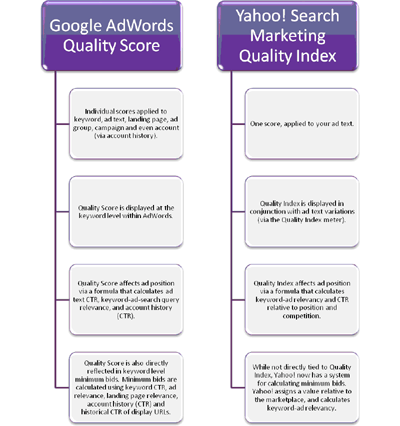Pay-Per-Click Quality Score

What Everybody Ought to Know About Pay-Per-Click Quality Score
by John Lee, Hannapin Marketing
Beware! Mysterious forces are at work in your pay-per-click campaign. Put simply, if you don't understand Quality Score, you are not in control of your PPC performance. Throughout the last three years, Quality Score has grown from a baffling Google-brainchild to an industry-wide standard practice. All the major search engines, from Google, to Yahoo! and even MSN have adapted some form of a "quality" factor when determining PPC ad rank. This factor hinges on keyword, ad text and landing page relevancy and demands ever higher PPC campaign management standards from advertisers. Learn to play the Quality Score game, or resign yourself to manage out-of-control PPC campaigns.
What Is Quality Score?
For this definition, let's defer to Google: "Quality Score is a dynamic variable assigned to each of your keywords. It's calculated using a variety of factors and measures how relevant your keyword is to your ad group and to a user's search query." In plain English, Quality Score is a ranking that is a direct reflection of how relevant a keyword is to your ad text and landing page.
Before Quality Score, PPC advertising was relatively straight forward. You created a keyword list, wrote compelling ad copy and set a bid. Your ad position was determined by your keyword bid, plain and simple. Google and Yahoo! were not closely monitoring the quality or relevancy of the advertisements being - a far from perfect system that created holes for irrelevant advertisers to muddy up the search results.
Google was the first to step forward and create a solution that rewarded advertisers for presenting highly relevant keyword lists, ad texts and landing pages. This progression by Google meant that advertisers could no longer bid for position, but would have to take it upon themselves to provide a quality user experience (i.e. serve relevant results) in order to achieve higher rankings and lower click-through rates (CTR).
Who Has Quality Score?
Google first launched Quality Score in August 2005, and are truly the originators and keepers of the name, "Quality Score." Yahoo! followed suit when they launched the "Quality Index" in February 2007 as the final phase of the Panama upgrade. MSN adCenter then launched "Quality Based Ranking" in April 2007. All of these systems incorporate similar formulas for determining relevance between your keyword, ad text, landing page and the user's search query. For the rest of this article, let's stick with calling all of these systems "Quality Score."
All of the major PPC search engines have instituted a quality based ad system for very particular reasons. Quality Score has helped boost paid search advertising revenues to all-time highs (especially for Google). Due to the way Quality Score rewards relevance, junk advertisers have found it difficult to maintain profitability with PPC. And at the end of the day, search engines really do want to enhance the user experience - satisfied searchers return and click on more ads, thus generating more revenue.
Differences Between Google and Yahoo!
For this discussion, let's focus on the Google and Yahoo! Quality Scores. There are some very obvious differences between these two search engines and their approach to Quality Score. The Google approach is extremely complex, shrouded in mystery and is all-encompassing of your AdWords account. Yahoo!'s system is less complicated and more straight forward.
Click image below to enlarge
Why Is Quality Score Important?
As previously mentioned, Quality Score is essentially a reward for relevance. The most straight forward explanation is that Quality Score directly affects your ad position and cost-per-click in the search engines. Improve your Quality Score, and you will increase your ad position and decrease your cost-per-click.
In Google, Quality Score is a part of the actual ranking formula. Quality Score X Maximum Bid = Ad Rank. The effect is more subtle in Yahoo!. Ultimately, if you maintain ads with a high Quality Index in Yahoo!, you will receive higher CTR and ad positions.
Now that both Google and Yahoo! employ a minimum bidding system, quality is an important factor in simply keeping your PPC campaigns active. In Google especially, the relevance of your keyword in relation to your ad text and landing page will be directly applied to your minimum bid. If your keyword is completely off-subject and irrelevant, the minimum bid will increase, and your keyword will be paused (i.e. "inactive for search"). If you improve relevancy, your Quality Score will increase and the minimum bid will be lowered!
How Can You Improve Your Quality Score?
There are some simple, yet powerful methods for boosting your Quality Score. The following checklist will help you to make the right changes in your PPC accounts to positively affect your Quality Score (Shown on pg 4). While going through these exercises, try to avoid the mindset of "this is only for Quality Score." Instead, adopt these exercises as every-day PPC management activities. Doing so will ensure that you have healthy, profitable campaigns in every PPC search engine!
There are countless tweaks and fine-tuning tasks that can be completed to boost Quality Score in all the PPC search engines. But this quick checklist will get you well on your way. Remember that Quality Score is all about relevancy and improving the search experience for the end-user - your potential customers. Keep in mind that optimizing your ad texts and landing pages for Quality Score is a must, but don't over-do it. Optimize for both searchers and search engines. If you can learn to play the Quality Score game, you will seize control over your PPC performance!
Checklist for Improving Quality Score
1. Break down your ad groups into tightly themed keyword groups. This is something you should always do! Never unload a large list of keywords into a single ad group. Always take the time to sort these into small groups. This stage is often called "optimization."
2. Write keyword rich ad texts. If you followed step 1, this should be easy. Taking the time to carefully write your ad copy to include your keyword in the headline and the description is a must. This tactic will improve your CTR which in turn can further enhance your Quality Score. It's a win-win situation. Remember that when searchers type your keyword in the search box, that keyword will be bolded in your ad text!
3. Write keyword rich landing pages. This too should be easy, assuming you have optimized your ad groups well. Place your keywords in the page title, headline and body content. This tactic is not far removed from writing content for SEO. Keyword placement on the landing page is a major determining factor in your relevancy and Quality Score.
4. Write on-topic landing pages. You could place keywords in your content all day long, but if the landing page has nothing to do with your keywords, product or service then it is a moot point. If you're an ecommerce site, send your PPC traffic to specific product landing pages. If you're selling a service, make sure that your landing page is specifically about that service and not just your homepage. Quality Score is truly about relevancy, so make sure that your landing page is holistically relevant to your keywords and ad texts. And don't forget, the load time of your landing page is also a factor in your Quality Score!
PPC Quality Score Resources
• Google AdWords
• Yahoo! Search Marketing: Quality Index - Minimum Bid
• The Adventures of PPC Hero:
- Quality Score HandBook
- Advice On Improving Google/Yahoo Quality Score
- Expand Your View On Google's Quality Score And See Your Campaign Grow










